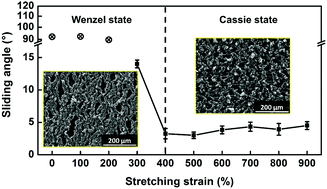Crack growth-driven wettability transition on carbon black/polybutadiene nanocomposite coatings via stretching†
Abstract
Ordered topography patterns with a mechanical response are usually designed to achieve wettability switching by geometric parameter changes through mechanical stimuli. However, their fabrication often needs expensive and complicated micro/nano-fabrication processing (e.g. photolithography and ion etching). In this study, a nano-carbon black (CB)/polybutadiene (PB) coating with a Wenzel superhydrophobic state was prepared on a rubber substrate by a facile method combining solution mixing and spraying coating. By stretching the composite coating, the generated cracks divided the continuous coating into new micro–nano mastoids, resulting in the formation of new hierarchical roughness for Cassie superhydrophobicity. The Wenzel-to-Cassie transition behavior was dependent on the CB loading in the coating. During stretching, the cracks propagated more rapidly in the coating with higher CB loading and induced the desired hierarchical structure to consequently enable the Wenzel-to-Cassie transition earlier at a lower stretching strain. The stretched coating presented good anti-wetting (a sliding angle of 5°) and low water adhesion. After releasing, the coating returned to its original Wenzel state by structure recovery. Thus, the switchable wettability of the coating can be adopted for no-loss water droplet transfer by controlling the droplet adhesion through cyclic stretching–releasing, and exhibits good potential for microfluidic and biomedical applications.



 Please wait while we load your content...
Please wait while we load your content...